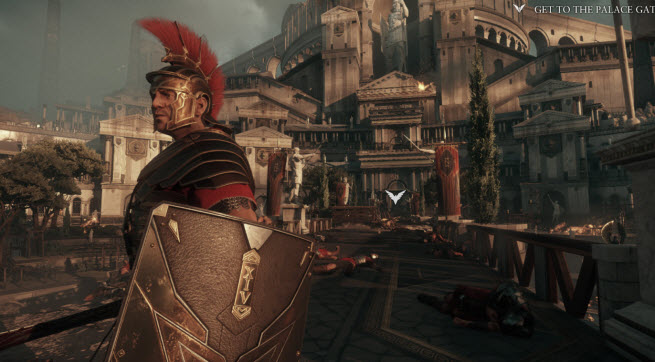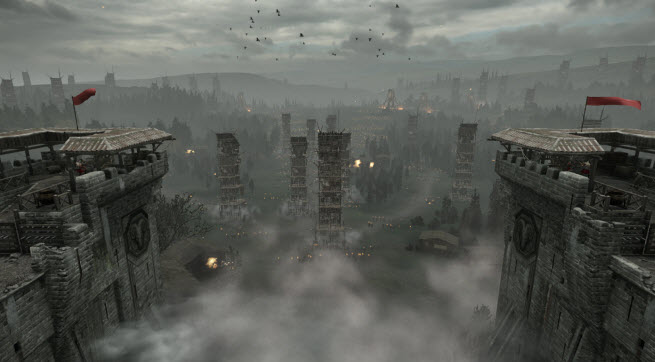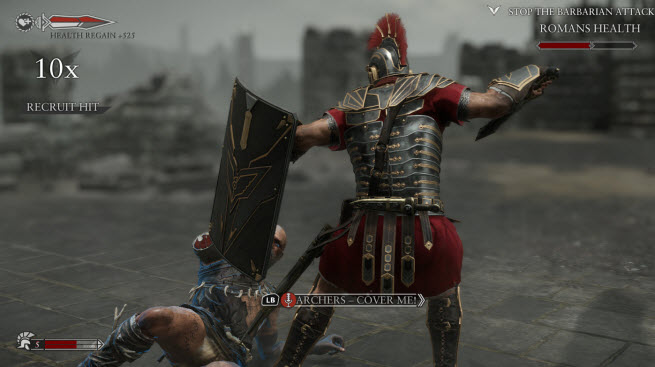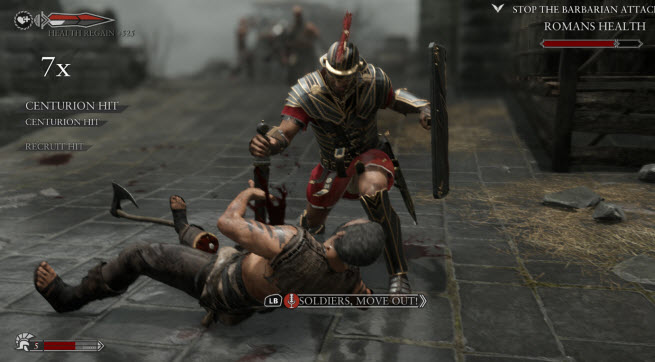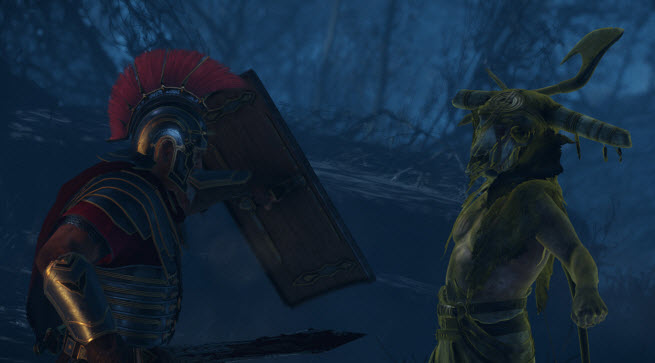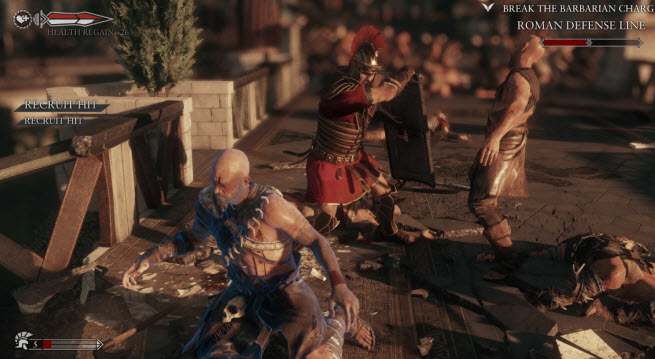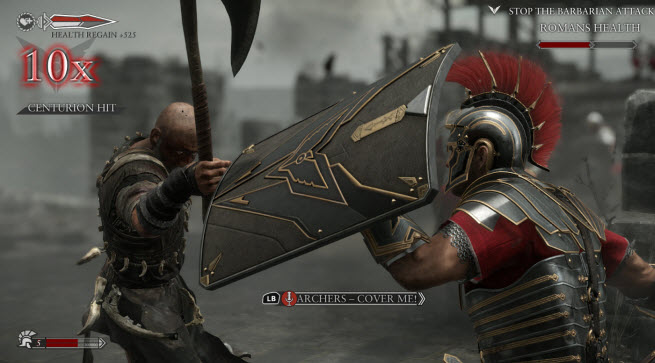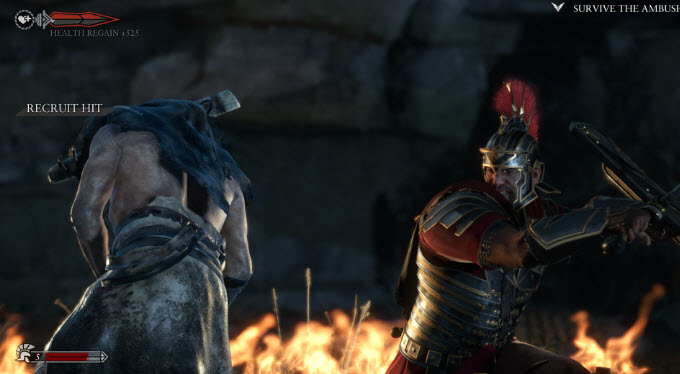Editor’s note: This review has some limited story spoilers.
Ancient Rome was a brutal place. You can read about it in the history books, or you can relive it one bloody body at a time in the new Xbox One exclusive video game, Ryse: Son of Rome. Microsoft has positioned this game as the marquee title for its new video game console, and it’s right to do so. Developer Crytek’s execution on Ryse seemed a little iffy earlier this year, as gamers reacted strongly to relatively weak demos.
But Crytek has revised the game in a significant way in the last five months. The final product is a joy to play — as long as you don’t mind all of the blood, dismemberment, and death screams. Visually, it is stunning enough to be worthy of a next-generation label. Its movie-like cinematics look like they were actually made by a film director, not a video game designer. They hold your attention and don’t go on forever. And the action is savage.
Ryse is a new intellectual property that Crytek worked on for seven years. During the past two years, the German developer rebooted the development and turned the title into an Xbox One launch title, one of 22 games that will be available when the system goes on sale early Friday morning. Ryse will stand out as a game crafted to be a next-generation experience. It’s by no means flawless, but it provides eight hours of fun.
Ryse could be a boring hack-and-slash game, as many swordfighting titles are. But it mixes up the button mashing, requiring the gamer to use more skill by executing finishing moves, particularly with more difficult enemies later in the game. And it also adds variety by making the player act as a general, commanding troops to move into action.
Ryse has a lot going for it. Great cinematics. Gripping action. A good story. Interesting characters. An epic tale. And plot twists that will surprise you. It’s a story about a Roman general, Marius Titus, who has a duty to protect Rome from the barbarian hordes but who also harbors his own quest for revenge. As he seeks vengeance against those who killed his own, Titus must weigh his duty to the empire and his moral obligation to fight its corruption.
What you’ll like
Epic scope and a good story
The very first camera shot of Ryse: Son of Rome gives you a view of barbarians attacking the beautiful imperial capital. Then the camera zooms in on a single soldier, Marius Titus, as he tries to fight off the barbarians. That shot tells you a lot about what you’ll see in this game. It has epic scope, pulling out to the big picture to show you that what you do as a soldier will matter in the long run. But it also has a personal focus on a single character.
One of the good things about Ryse isn’t that it is historically accurate. It isn’t. It pulls some of the best parts of Roman history into a drama. The story starts in the middle of things, as Rome is under attack. You have to fight your way through a bunch of barbarians and protect the emperor, Nero. You and Nero are drawn into a conversation, and then the story flashes back to the past. When the story is told, you’ll know how you wound up as the last defender of Rome.
In the battles, you find yourself surrounded by barbarians on a narrow bridge in Rome. You embark upon Roman galleys, leading an invasion of the British shores amid a horrendous catapult counterattack. You march into the darkness where enemies await you in the night, and you sneak through the forests hoping you won’t be discovered by a large force. You lead your soldiers into one battle after another.
In this story, you live through events that are pulled from hundreds of years of Roman history. You’ll get a taste of the excesses of Roman nobility as you witness the spoiled Patricians treat their slaves with utter contempt. You can walk into the Colosseum as a gladiator and hear a deafening roar as the crowd cheers you.
Gripping action
If you’ve ever seen someone screaming and yelling in sheer rage or fear, you’ll know what it’s like to play Ryse. This is a game where the characters are almost always yelling fierce, blood-curdling battle cries. You go from one fight scene to the next. Naturally, this isn’t a game for your kids to play or watch. But its core game mechanic of fighting and the animations that go with it are enthralling.
I played the game on Soldier level, one level above Recruit but two levels from the top. It was a difficult game where I had to repeat some sections over and over again. But I believe I finished the eight chapters in about eight hours. That’s a little short for an epic. But it wasn’t dull.
The action was gritty, hand-to-hand melee combat. In the age of modern shooters, too many games have removed the player from the visceral nature of combat. You might as well be a robot when you shoot a distant enemy through a sniper scope. With Ryse, the killing is up close and personal. Doing this properly is a tough thing.
For instance, you can’t make the player seem too powerful, like in some scenes in God of War, or the game becomes too easy. As Marius, you are a great warrior. But you are not invincible, and you cannot survive against impossible odds. You must earn every kill, one violent blow at a time. Ryse does a great job conveying the brutality and searing experience of 1-on-1 combat. The bosses are sufficiently difficult, and beating them in the arena is ultimately very satisfying.
Being a commander is fun
As a general, Marius Titus must direct the actions of his legion. He can form a “turtle” formation, where legionnaires put their shields right next to each to protect each other from arrows. As enemies fire arrows, you turtle up. When they’re reloading, you can command the soldiers to throw spears at the archers. You can never hit every enemy, and you have to pick and choose.
In these commander scenes, you have to break out now and then and fight a sword duel. Then you can go back to being a commander. I had a lot of fun shooting Scorpions, which seemed like giant crossbows, at hordes of charging barbarians. When you hit a vat of burning oil, you can spread fire to a bunch of enemies. This kind of gameplay gives Ryse a lot of variety, and it keeps it from devolving into a hack-and-slash treadmill.
For good or bad, the commander mode is the only time you’ll use Kinect in the game. As you fire the Scorpion, you have to give your archers commands to fire volleys. You can do that by holding the left bumper on the controller, or you can simply yell, “Fire volley.” It worked for me some of the time, and sometimes it didn’t. For the most part, Kinect didn’t pass its test.
Good characters
Titus looks remarkably real up close, with razor stubble on his face and scars from many a battle. That beautiful character animation goes hand-in-hand with excellent dialogue and voice acting. You could tell that Crytek spent a lot of time crafting a character with a real set of relationships, a backstory, and emotional conflicts. Titus is pulled in a variety of directions, with impulses toward kindness, justice, fury, revenge, duty, and strategy. He is surrounded by characters who may be friends or foes. They may help him on his quest, or betray him. Ryse is mostly about Titus, and I wish there were more characters that you get to know in the Rome universe, but he is very well done.
A good storyteller doesn’t always respect the audience’s first impressions. Characters who seem to be cowardly or wise may turn out to be something else. Ryse’s characters have this kind of deceptive quality. The story reveals their true character, and that makes the narrative more fun. With Titus, you’ll see that his story has an arc.
Crytek listened to feedback from the fans
One of the highlights, as mentioned, is when you execute a finishing move on a wounded opponent. As you do so, you stop mashing the buttons and shift to pulling the right trigger. If you do it right, you’ll initiate an execution. Then the opponent is vulnerable to your single-button mash attack.
When the media saw the game at E3 in June, Ryse wasn’t ready. When you were about to execute someone, an enormous QuickTime Event (QTE) icon appeared in the middle of the screen. You had to quickly respond by matching the color of the icon, blue or yellow. That imagery was ridiculous because it pulled you completely out of the immersive simulation and banged you over the head with “This is a video game!” You couldn’t see the beautifully drawn character animations because the icon was so distracting.
Now the imagery is more subtle. Instead of a big icon, now you see the outline of your victim change color to blue or yellow. You press the appropriate button and then the finishing sequence commences. With this system, the color choice is still visible but isn’t distracting.
Of course, now the problem is that you sometimes can’t see the body of your opponent at all, and then you don’t know what button to push.
Cool graphics that will shine on the next-generation machine
With a new console, game developers are bound to include plenty of “show off” scenes where the camera lingers over a waterfall, a fiery blaze, or a crumbling wall — just so that you can see that the game can do cool graphics. Ryse has plenty of these show-off scenes. Titus runs through water. He takes an occasional long view of a beautiful vista, and he sees through fire. The special effects are pretty.
But this game has some genuine moments that will make your jaw drop. It is built with Crytek’s CryEngine, which can render 3D graphics that will make your eyes melt from time to time. When the characters are talking to each other, you don’t see the usual flaws that you expect to see.
Gladiator combat for multiplayer
Ryse seems like a good bargain as a single-player campaign. But you can step into the Colosseum of Rome and battle in multiplayer. You can fight for gold, earning currency to buy weapons, armor, and in-game items. This is a natural way to do multiplayer in a game where you don’t really expect it. It’s a bonus that adds to the number of hours you’ll spend with the game. And who wouldn’t want to hear the cheers of the crowd inside the arena?
What you won’t like
Ryse is on rails
Ryse: Son of Rome is a game on rails. That means it moves from one scene to another in a linear path, often giving the player the illusion of choice, but in reality requiring them to stay on the prescribed path. Sometimes that isn’t a problem, like when you fight your way into a large arena. You can fight in that arena any way you want. But you have only one exit to the next scene. That kind of controlled behavior is fine. But it also has scripted sequences where the game had some interaction mixed with cinematics. It sometimes seemed not to matter how you interacted. The outcome was always the same.
There were times when the game was too much like a movie, showing you visuals instead of gameplay. In those cases, I paid close attention to whether I had any choice in the various scenes that unfolded before me. Often, I did not. I think Ryse would have benefited from having more instances where the player could choose what would happen next. It felt too inevitable.
But Ryse does a good job of extending the illusion of choice at some times. When I ran through a forest, I admired how beautiful it was. I knew that there was only one path through the forest. But I pretended not to notice and looked around at the scenery.
Gameplay gets repetitive
As our previewer McKinley Noble noted, you can play the whole game just mashing down the buttons in an X, X, X, and Y pattern. And when you see the blue or yellow finishing colors on your victims, you suffer no consequences if you hit the wrong buttons.
Even worse than the repetitive gameplay are the repetitive animations. When you slice off an opponents arm, there’s no stream of blood. Rather, you see a neatly slice arm cross-section with red and white sections for the meat and the bones. This grabs your attention the first time you see it. But after the hundredth time, you start wishing that Crytek had created a few more animations.
In any game, this kind of repetition could be a killer. It was why an excellent game like Alan Wake on the Xbox 360 received a less-than-outstanding rating. But the good thing about Ryse is that there is some variation. You have to change your formula for button mashing quite often. That’s particularly true when you are surrounded by three different types of characters. Those characters attack and defend in different ways. To fend them off, you need to do things like block, run, or maneuver. And the boss characters require you to fight in a different way altogether. This is the saving grace of Ryse.
It reminds you of something else
Ryse has some beautiful cinematic moments, but they may remind you of other scenes from the movies. Those scenes may be cool, but they will extract you from the fantasy and ruin some of the fun.
For instance, when the Romans storm the beach in Britannia, they have a tough time. A catapult lobs a flaming rock that nearly misses Marius and knocks him for a loop. Marius is stunned into slow-motion movement. His hearing goes blank and his vision is fuzzy. That tells you that our hero isn’t invulnerable, but he gets up again and continues to fight bravely. It’s a nice moment, but we’ve seen it before in Saving Private Ryan. I could understand a World War II video game imitating a scene from Saving Private Ryan, a World War II movie. But it’s pretty distracting in Ryse.
I also had an interesting moment when Titus goes to the Edge of the World, standing upon Hadrian’s Wall on the dividing line between the barbarians and Roman civilization. But the talk about the evil beings beyond the wall just made me think about HBO’s Game of Thrones. Sure, the real Hadrian’s Wall came first. But Game of Thrones is fresh in everyone’s minds. Did they really have to imitate it?
The opportunity to create a new intellectual property is a rare thing in today’s video game industry. Very few game designers get their chance to work on something original. So when they get to work on something original, they should do that, and not steal someone else’s drama.
Imprecise controls
When a reviewer complains about bad controls, it’s usually a case of operator error. But I think that many problems that players have come back to the design of the game. For instance, with Ryse, you have to climb a lot of ladders. Sometimes you can charge the ladder and just run right up it. Other times, you miss and have to take a few runs at it to get up the ladder. For god’s sake, game designer, just make the ladder bigger.
Another case is where you walk into a trap in the forest. If you take a step onto the trap, it springs, giving you a moment’s notice to defend. If you hit the A button at the exact right time, you’ll block the trap and stop it from driving a stake into your body. But I often found that it was very hard to get the right timing so that I could stop the traps from taking me out. It’s a minor annoyance, but it sure made me feel frustrated.
OK, it’s not real history
There are some definite historical mistakes in the story that will leave purists a little miffed. A British ruler rides into battle atop a war elephant. It is a very impressive and scary sight in battle. It may be quite possible for an English lord to find an elephant, but I’m not exactly sure how the Brit imported a bunch of elephants from North Africa or India at that time.
I’m not sure why the Romans speak with British accents, but they do. That is a creative choice, since, for practical purposes, the Romans are also speaking English instead of Latin. But it becomes a bit of a farce when the Romans square off face-to-face with the Brits. And then they both speak with the same accents. If you like your history to be accurate, this isn’t your kind of video game.
Where’s the way out?
I often blazed right through the combat. Then I spent way too much time wondering where the exit to the scene was. I would run around looking for a telltale sign that showed me the path to the next scene. Sometimes, the path was obvious and disguised in a way that made the exit seem a natural part of the landscape. But there were other times when it I felt like a rat in a maze, searching for the escape route. Sometimes I had to find a ladder, or a step, or a wall that I could climb. Sometimes the way out was a path through the forest. If the game was only eight hours long, I was upset that it felt like I spent six hours trying to find my way to the next level.
Microtransactions. Really?
You can dish out more money to Microsoft beyond the $60 you paid for the game by purchasing in-game items with real money. You can earn valor points in the game to earn your upgrades such as better healing or improved combat prowess. But late in the game, the number of valor points you have to earn in order to purchase more attributes becomes prohibitively expensive. So Microsoft provides a short cut: You can purchase “gold” with real money. You can spend that gold on the items that you need and make much faster progress than you otherwise might. You don’t have to spend this money. But the very presence of microtransactions inside a game you have already paid for is pretty annoying. You’ll feel like you’re being nickel-and-dimed.
Conclusion
When I finished playing this game, I felt like I wanted more. That’s the mark of a good game. I also felt like I had played something fresh. If there were 20 games about Rome, this one might not stand out as the most outstanding. But it’s good, and there aren’t enough tales with a historical background that wind up being big budget video games. I’m glad that Crytek stayed the course on its seven-year journey and finally finished Ryse.
You will be, too.
Score: 86/100
Ryse: Son of Rome debuts on Friday, Nov. 22, for the Xbox One. The publisher provided GamesBeat with an advance copy of the game for the purpose of this review.

VentureBeat's mission is to be a digital town square for technical decision-makers to gain knowledge about transformative enterprise technology and transact. Learn More

